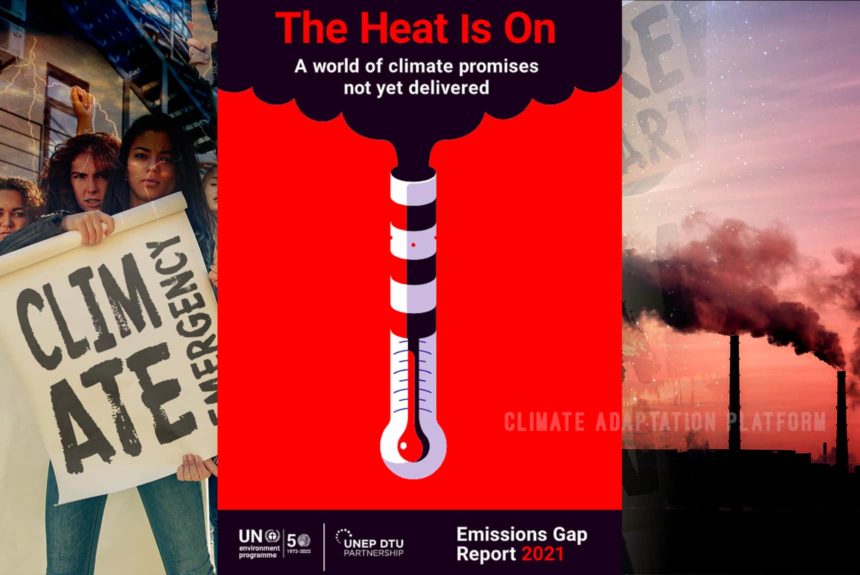The United Nations Environment Programme (UNEP) 12th edition emissions gap report comes in a year where a series of extreme climate events – record-breaking temperatures, wildfires, floods, and droughts- have bombarded headlines worldwide, reminding us that climate change is at our doorsteps.
The 2021 IPCC Report that the UN Secretary-General dubbed as a “code red for humanity” has shown unequivocally that the build-up of GHG emissions in the atmosphere due to human activities caused climate change and extreme events.
The IPCC report also warns that the world has a 50% chance of exceeding the 1.5°C temperature limits within two decades. Unless there is immediate, rapid, and large-scale GHG emissions reduction, limiting warming to 1.5°C or even 2°C by the end of the century will become unreachable.
The evidence from the IPCC report is the foundation for the United Nations Climate Change Conference of Parties (COP26) to push for rapid and increased ambitions on climate adaptation and mitigation on member states through their Nationally Determined Contributions (NDCs).
Member states are requested to submit new or updated NDCs that are a step up from their previous ones and aim for more ambitious targets.
The Emissions Gap Report 2021, ‘The Heat is On’ shows that the new and updated NDCs submitted ahead of CO26 and combined with other mitigation pledges will put the world on a path to a global temperature rise of 2.7°C by 2100, even if they met all new unconditional commitments.
According to the report, additional net-zero targets could reduce global warming by another 0.5°C, but these plans are currently ambiguous and not fully reflected in NDCs. To date, 49 countries plus the European Union have firmly committed to net-zero emissions goals by 2050.
According to the report, to keep global warming below 1.5°C this century, the world needs to urgently put additional policies and action to halve annual greenhouse gas emissions in the next eight years.
The emissions gap refers to the difference between where we will likely be (based on what countries have promised to do in their NDCs) and where we need to be (emissions reductions or pathway recommended by the UN to limit global warming to below 2°C and pursuing 1.5°C).
“The report is organized into seven chapters, including this introduction. Chapter 2 assesses the trends in global GHG emissions and how they are affected by COVID-19 and provides a global and G20-member-specific overview of new, updated, and announced NDCs. Chapter 3 provides an assessment of net-zero emission pledges. Chapter 4 updates the assessment of the likely emissions gap in 2030, based on new or updated NDCs as well as officially announced mitigation pledges for 2030. The chapter then looks at the implications of the emissions gap on the feasibility of achieving the long-term temperature goal of the Paris Agreement. Chapter 5 assesses the extent to which COVID-19 fiscal rescue and recovery measures to date can support low-carbon or high-carbon development. It also looks at the disparities between high-income and developing countries. Chapter 6 assesses the role of methane in the NDCs and in bridging the emissions gap and considers options for cost-effective reductions of the otherwise growing emissions of methane. Finally, Chapter 7 looks at the potential role of market mechanisms in implementing NDCs and enhancing future ambitions and discusses what is required to make the use of markets environmentally effective, transparent and credible” (Ohlhoff & Christensen, 2021).
Key takeaways from the Emissions Gap Report 2021:
- Updates to NDCs under the Paris Agreement follow the trajectory of weak promises, not yet delivered.
- The bad news comes against a background of post-pandemic emissions bounce-back and rising atmospheric concentrations of CO2.
- The opportunity for using COVID-19 fiscal rescue and recovery spending to stimulate the economy while fostering a low-carbon transformation has been missed in most countries so far.
- Zeroing in on net-zero could make a big difference, but current plans are vague and not included in NDCs.
- Reduction of methane emissions from the fossil fuel, waste and agriculture sectors can contribute to closing the emissions gap and reduce warming in the short term.
- Carbon markets can deliver real emissions abatement and drive ambition, but only when rules are clearly defined, designed to ensure that transactions reflect actual reductions in emissions, and are supported by arrangements to track progress and provide transparency
To read UNEP’s ‘The Heat is On’ report, click any of the buttons below:
Source Citation:
Olhoff, A. & Christensen, J. (2021, October 26). Emissions Gap Report 2021. Relief Web. Retrieved from https://reliefweb.int/report/world/emissions-gap-report-2021
Emissions Gap Report 2021 – Key Messages. UNEP. Retrieved from https://reliefweb.int/sites/reliefweb.int/files/resources/Key%20Messages_0.pdf
United Nations Environment Programme (2021). Emissions Gap Report 2021: The Heat Is On – A World of Climate Promises Not Yet Delivered. Nairobi. Retrieved from https://reliefweb.int/sites/reliefweb.int/files/resources/Emissions%20Gap%20Report%202021.pdf



Leave a Reply